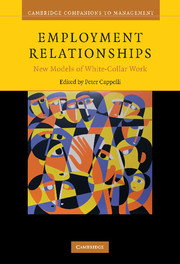Book contents
- Frontmatter
- Contents
- List of figures
- List of tables
- List of contributors
- Foreword
- 1 Introduction
- 2 Corporate restructuring and the employment relationship
- 3 The up and out in organizations
- 4 In the pursuit of quality and quantity: the competing demands in call centers
- 5 Three's a crowd? Understanding triadic employment relationships
- 6 The changed world of large law firms and their lawyers: an opportune context for organizational researchers
- 7 The upside of bureaucracy: unintended benefits for professional careers
- Index
- References
7 - The upside of bureaucracy: unintended benefits for professional careers
Published online by Cambridge University Press: 02 December 2009
- Frontmatter
- Contents
- List of figures
- List of tables
- List of contributors
- Foreword
- 1 Introduction
- 2 Corporate restructuring and the employment relationship
- 3 The up and out in organizations
- 4 In the pursuit of quality and quantity: the competing demands in call centers
- 5 Three's a crowd? Understanding triadic employment relationships
- 6 The changed world of large law firms and their lawyers: an opportune context for organizational researchers
- 7 The upside of bureaucracy: unintended benefits for professional careers
- Index
- References
Summary
Introduction
There is a frequent refrain from scholars and practitioners alike that the professions are becoming ever more bureaucratized. If true, what does this trend imply for professional careers? Several volumes have been devoted to the implications of bureaucratization in general, nearly all of which see it negatively from the point of view of professional workers themselves (e.g. Derber, 1982; Leicht and Fennell, 2001; Freidson, 2001). In this chapter I advance another, perhaps less obvious, interpretation: that bureaucracy offers those in professional careers the kind of career flexibility that today is welcomed. I argue that bureaucratization is (largely unintentionally) creating a range of flexible career options that were previously unavailable – and that are increasingly valued by professional workers themselves. I advance this argument using data from a multi-method study of primary care physicians.
A review of the historical and current trends in professional organizations (e.g. law firms, medical practices) in the research literature shows that they are indeed becoming more bureaucratic. This process entails a greater use of formalized rules and procedures (Gerth and Mills, 1946), and more centralized control of professional activities and client relationships (Pugh et al., 1968). Some of the resulting effects on careers are straightforward. For example, bureaucracy tends to increase the demand for professionals to take on managerial roles (see Rothman and Perrucci, 1970, and Raelin, 1985).
- Type
- Chapter
- Information
- Employment RelationshipsNew Models of White-Collar Work, pp. 223 - 256Publisher: Cambridge University PressPrint publication year: 2008
References
- 1
- Cited by



